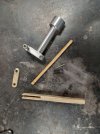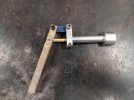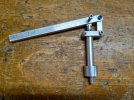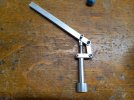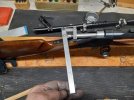Snakeoil
Well-Known Member
The load testing with the .218 Bee and knowing that the cartridge was never intended to use cast bullet is making the whole process lose its luster. I have some more test rounds I'll probably shoot today, but not very excited about it.
I have the Browning 1885 Classic in .38-55 and would like to revisit that rifle. Been reading posts in other forums about the rifle and think it is worth the effort to revisit the 225 and 250 gr bullets. Twist is 1:15 which lends itself to the lighter bullets. Comments at the club say that they lose their accuracy beyond 500 yds. But I think it's worth the effort, since I already have the rifle, to pursue it further.
I suspect my initial efforts were disappointing because of the bullets I was using. Rifle came with 1500 cast bullets by Lasercast and NBC. Both are glass hard and bevel based. I ordered some from Maplewood and told him I wanted 20:1, but his look to be wheel weights or harder. My groups during load test were nothing to write home about. I did not even save the targets. I do have about 80 Montana Bullet Works bullet that are 15Bnh (not cheap) and may try those again. I can borrow a mold from Charlie or one of the othe members and cast up different bullets before I find a keeper and then order a mold for that bullet.
Part of the revisit is I'm thinking about making a breech seater. I've been threatening to do this for quite a while but ever got around to it. With winter here, this is a good time to make some chips and get the job done.
I thought about selling the rifle since I want to stay away from heavy recoil due to that floater in my left eye. But with a 225 or 250 gr bullet, it should not be much worse than my 03 with 210 gr bullets. Plus, it is such a pretty gun that I hate to part with it. I see that George Peterson is making wood for these now. So maybe I'll restock it with a shotgun butt and pistol grip stock and put the original wood away. It's all therapy, right?
I have the Browning 1885 Classic in .38-55 and would like to revisit that rifle. Been reading posts in other forums about the rifle and think it is worth the effort to revisit the 225 and 250 gr bullets. Twist is 1:15 which lends itself to the lighter bullets. Comments at the club say that they lose their accuracy beyond 500 yds. But I think it's worth the effort, since I already have the rifle, to pursue it further.
I suspect my initial efforts were disappointing because of the bullets I was using. Rifle came with 1500 cast bullets by Lasercast and NBC. Both are glass hard and bevel based. I ordered some from Maplewood and told him I wanted 20:1, but his look to be wheel weights or harder. My groups during load test were nothing to write home about. I did not even save the targets. I do have about 80 Montana Bullet Works bullet that are 15Bnh (not cheap) and may try those again. I can borrow a mold from Charlie or one of the othe members and cast up different bullets before I find a keeper and then order a mold for that bullet.
Part of the revisit is I'm thinking about making a breech seater. I've been threatening to do this for quite a while but ever got around to it. With winter here, this is a good time to make some chips and get the job done.
I thought about selling the rifle since I want to stay away from heavy recoil due to that floater in my left eye. But with a 225 or 250 gr bullet, it should not be much worse than my 03 with 210 gr bullets. Plus, it is such a pretty gun that I hate to part with it. I see that George Peterson is making wood for these now. So maybe I'll restock it with a shotgun butt and pistol grip stock and put the original wood away. It's all therapy, right?

